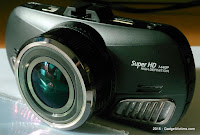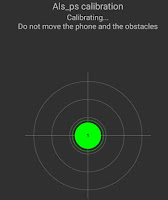
The Ausdom A261 is a complete dash cam product based on the famous A7LA50/OV4689 winning team and a built-in GPS.
Highlights:Video Resolution :
2304x1296 30P 16:9 / 2560x1080 30P 21:9 1920x1080 45P 21:9 / 1920X1080 30P 16:9 HDR 1920X1080 30P 16:9 / 1280X720 60P 16:9; 1280X720 30P 16:9
Image Resolution : 4M (2688×1512)
F/2.0 6G heat resistant lens, 130 degree view angle

Support auto power on / off
Support night vision / motion dection / loop recording / G-sensor
Support up to 64GB microSD (tested and works)
2 inch TFT screen
Chipset: Ambarella A7LA50
Sensor: OV4689
Battery: 250mAh, rechargeable
Mounting: Suction cup with T-slot fixing
LDWS/FCWS, Parking mode
 Unpacking and product design:
Unpacking and product design:Unlike Dome with their huge range of models and variants, Ausdom focuses on a
selection of models but with special care to the details.
The neat packaging announces already something superior.
It contains the A261 unit, 1 Car Charger, 1 Mount Bracket, 1 USB Cable, 1 Power Cable, and the User Manual.
The camera compares in shape with a
HP F500G or
Transcend Drive Pro 220 and the only thing cheaper here is the price.
On one side is the power button and the MicroSD card slot, on the other, a Mini-HDMI, a micro-USB connector and a reset button. The back side has a 2"/5cm TFT screen with 4 buttons.
The UP button also allows to mute the microphone or to switch to the HDR mode resolution (long press) and the DOWN button doubles as a SOS button (to write-protect the current recording segment). The available functions are clearly displayed on screen above each button.
The T-slot on the top makes it easy to attach and remove from the suction cup bracket.
Firmware: CAR DV 50 ARAK150718AAll the functions provided by the Ambarella chipset are available from the menu. The interface supports English and Russian only.
While the "beep sound" can be muted in the settings, the loud Ambarella jingles can't, and there's no volume setting available.
GPS:
An embedded GPS can be a challenge for some manufacturers, but Ausdom did a great job. The A261 gets the fix in a matter of seconds (less than 15). For instance, the
CDV300X -also with embedded GPS- needs up to 4 minutes. The time setup needs however to be visited to specify the right time zone.
 Battery life:
Battery life:250mAh battery gives an appropriate autonomy to the camera so it can be used outside the car. Unlike other models tested that turn off due to empty battery shortly after being disconnected, this one gives about 8 minutes of recording time and 15 in standby on paper. I actually got 25 minutes of mixed use with motion detection activated.
The 4mpix sensor takes good snapshots but unlike the video, is not dewarped.
A real user manual:
The
user manual is above average and deserves to be mentioned. The 9 pages cover many points that others don't bother explaining, like how to properly calibrate the LDWS/FCWS.
In addition to English, there are translations French Russian German Spanish and Italian.
Audio and Video Quality:
Coupled with the Ambarella A7LA50 chipset, the 4 Mpix OV4689 sensor supports LDWS, HDR and Dewarping.
The audio quality is excellent with no interference. The microphone proved to be sensitive enough to catch clearly a conversation from outside the car with the engine running.
Video player:
The mini-CD provided contains a "GPS Player" software for Windows. It is quite basic and very slow at loading the videos. FHD files would eventually play but any UHD file will crash the player.

The popular
Registrator Viewer, as always, is a preferable alternative, but it has a strange bug, translating the speed from this camera as twice the actual value.
Ausdom encodes the GPS data in
movLogDVR format (most others makes use
movMap800 or
movDOD_D) which is stored in a displayable subtitle track. This allows to see right values with VLC or MPC and confirms that the camera is not in cause.
Workaround: Export and re-attach the GPS track. It will then display the right speed.
Conclusion: The Ausdom A261 succeeds where many others fail.
I've been reviewing a lot of dash cams lately and this Ausdom camera is a refreshing change.
It demonstrate how good a car camera can be when it's designed the right way.
The A261 is a high quality product in every aspect: packaging, camera, accessories, and documentation. Their other products are highly rated in the user reviews so this dash cam is in line with the company's quality standards.
For me, the dream dash cam would be this A261 in the wedge shape adopted by A118 and CDV300X, but otherwise I can fault it on any point.
The Ausdom A261 is highly recommandable and competitively priced at 83.99$/~75€ at
Gearbest.com
Good:
- A7LA50/OV4689 for high quality UHD picture
- Good audio recording quality and sensitive microphone
- Fast and accurate embedded GPS
- Clear and complete documentation
- Great design, interface easy to use with direct access to the most used functions.
- Nice looking/quality feeling for both packaging and product
- Battery life gives up to 25 minutes of use.
Not so good:- No audio volume setting
- Ambarella jingles cannot be muted
More information:Product pageAusdom forumUser manual
Look-alikes:
Special thanks to Lindell @ GearBest for providing this sample.











































